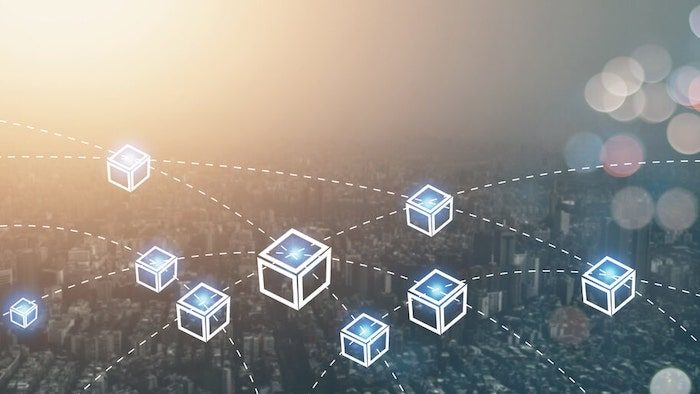By the Food and Agriculture Organization (FAO) of the United Nations
To feed more people without exacerbating the climate crisis, we urgently need our agrifood systems to become more efficient, inclusive, resilient and sustainable.
One way of achieving such an ambitious objective is to leverage the potential of modern, innovative technology. And with all the technologies that have emerged, blockchain is truly one that holds great promise.
Born in 2009 as an application for the virtual currency Bitcoin, blockchain is essentially a shared and decentralized database. However, unlike traditional databases, it uses a digital ledger that is simultaneously duplicated and distributed across a network of nodes on computers or servers. As new data comes in, it is entered into a fresh block. Once the block is filled with data, it is chained onto the previous block and the data within it is locked.
There are two key advantages to this distributed ledger technology: Records are immutable, since they are virtually impossible to change or hack; and the decentralized nature of the network means no single person or group controls the data, so fraud is less likely.
Such benefits go well beyond the world of virtual currencies. When it comes to producing food for human consumption, feed for livestock or timber for homes, traceability and transparency ensure that we know that such products come from a safe source or that materials are from a sustainable provider, enhancing food safety and making recalls easier. Blockchain can also facilitate trade and provide greater legal certainty to land tenure systems.
Traceability and transparency are also crucial to monitoring climate goals and related adaptation and mitigation actions. For example, better carbon accounting using blockchain technology can help countries keep their greenhouse gas emissions in line with their commitment to the United Nations’ 2015 Paris Agreement.
How Blockchain Would Work in Agriculture
But how exactly would it work? Let’s take the hypothetical example of a forester:
The forester sells the timber, and a forest institute confirms that the timber logging is legal, including its geographical coordinates. This information goes in the first block. FAO’s Hand-in-Hand geospatial platform, a Geographic Information System that provides rich, shareable data, could be used to validate the validity of the previous claim. This goes into the second block.
The country’s ministry confirms the legality of the practice of that specific timber. Block number three.
Another independent institute independently confirms the legality of the practice of that specific timber. The last block. In this example, the blockchain contains all the information that a wholesaler needs to trace the timber’s origin and legality.
A similar application is being explored with regards to assessing the risks of child labor associated with the production of chocolate bars. In this scenario, the end consumer would have additional guarantees about such risks by retrieving the relevant information, independently verifiable by a third-party source, through the product label’s QR code.
In fact, any single commodity could theoretically be represented by a Non-Fungible Token (NFT), which can represent digital and real-world objects, and blockchained to track its origin and path to the consumer. There are already examples in afforestation practices in which every new tree is linked to an NFT, thus helping combat green washing claims and ensuring the permanence of the tree (which would be continuously validated by satellite imagery).
FAO's Future of Blockchain in Agriculture
FAO is mainly involved in making sure there’s high-quality data to support transparency, traceability and sustainability claims for every food commodity.
A real-world example of FAO’s work in this area took place in Papua New Guinea. Here, rising global demand for pork presented new export opportunities, but only if farmers could prove the quality of their product. Together with the International Telecommunications Unit, FAO worked on a distributed ledger system pilot – based on blockchain – that can track livestock and allow consumers to buy with confidence by verifying the history of the pigs.
Using radio-frequency identification tags and a smartphone app, farmers kept digital records of how they raised their animals – proving the pigs received a diet of sweet potatoes, for example or were administered the proper vaccines. Thanks to this digital history, buyers were assured of the product’s quality, while farmers earned a fairer return on their investment.
The system was piloted in Jiwaka, and FAO is exploring the possibility of extending the pilot to other project sites.
FAO is also currently collaborating with the Wageningen University in the Netherlands to explore other uses of blockchain, for instance in monitoring child labor risks and forest management.
Blockchain is still in its infancy and faces its own challenges, not least in terms of the vast amounts of energy consumed by the underlying technology. But it also offers plenty of potential, for instance by creating the conditions for producers to one day satisfy international standards for exporting livestock.
These technologies are key to helping transform our agrifood systems for a better tomorrow.



![[Technology Corner] Deere Upgrades Allow Farmers to Take Smaller Steps with Precision Tech](https://www.precisionfarmingdealer.com/ext/resources/2025/03/13/Deere-Upgrades-Allow-Farmers-to-Take-Smaller-Steps-with-Precision-Tech.png?height=290&t=1741960939&width=400)


